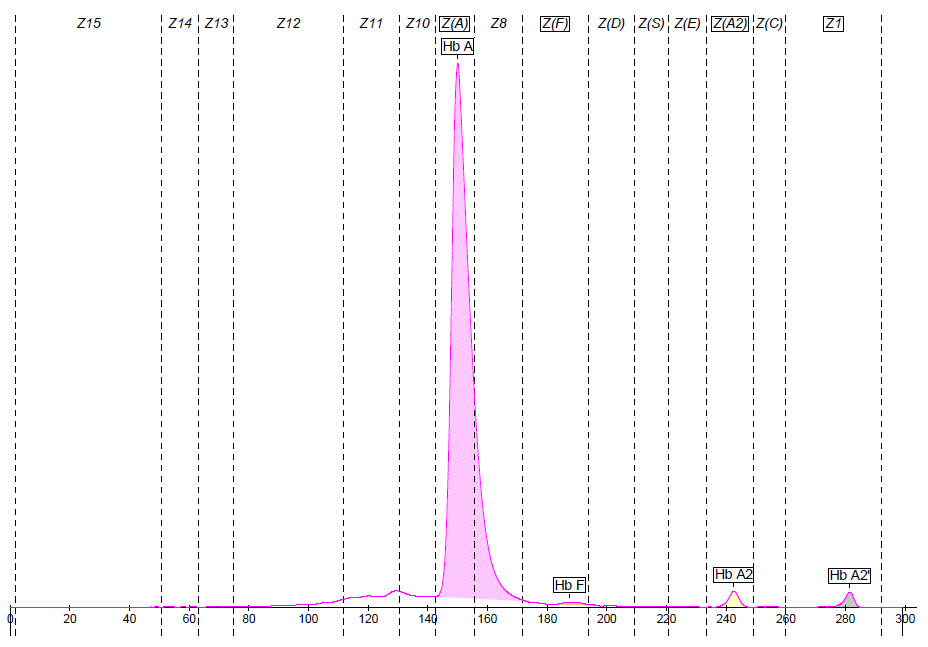General information
Globin chain involved
Status
Heterozygous
Migration zones
Migration positions
282
Sickle Cell Disease: No
Thalassemic variant: No
Capillary Electrophoresis
Fractions
Value %
Hb A
96.6
Hb F
0.6
Hb A2
1.5
Hb A2'
1.3
Comments
To detect cases of beta-thalassemia, it is necessary to add the percentage of the variant Hb A2' to the Hb A2 fraction.
Mutation data
Heterozygous Hb A2'
Mutation
HGVS Nomenclature
Delta 16(A13) Gly>Arg
HBD:c.49G>C
Hematological parameters
Name
Result
RBC Count
No information
Total Hemoglobin
No information
MCV
No information
MCH
No information
Blood smear
No information
Other analysis
No information
Comments on hematology
Clinical context
Clinical presentation
Due to their low concentration, Delta-globin chain variants are asymptomatic
Clinical risk
No data
Variant information
Stability
No data
Oxygen affinity
No data
Ethnicities in literature
Found mainly in Black populations: occurs in nearly 1% of African-Americans, met in West Indies families, in the Omani population and also in a 10-month-old Thai infant
Comments on variant information
Hb A2' is the most common delta-globin chain variant. It has been observed in heterozygous and homozygous status, and also in combination with Hb S, Hb C, beta-thalassemia (in cis and in trans)
Scientific Literature
Scientific references
- https://pubmed.ncbi.nlm.nih.gov/5956309/ Ball EW. et al., Nature. 1966 Mar 19;209(5029):1217-8.
- https://pubmed.ncbi.nlm.nih.gov/6058951/ Jones RT. et al., J Biol Chem. 1967 Nov 10;242(21):5141-5.
- https://pubmed.ncbi.nlm.nih.gov/1698102/ Codrington JF. et al., Blood. 1990 Sep 15;76(6):1246-9.
- https://pubmed.ncbi.nlm.nih.gov/21417568/ Daar S. et al., Hemoglobin. 2011;35(2):117-24.
- https://pubmed.ncbi.nlm.nih.gov/25117100/ Oleske DA. et al., Ann Clin Lab Sci. 2014 Summer;44(3):291-3.
- https://pubmed.ncbi.nlm.nih.gov/31037981/ Intasai N. et al., Hemoglobin. 2019 Jan;43(1):63-65.
- https://pubmed.ncbi.nlm.nih.gov/33054450/ Rets AV. et al., Hemoglobin. 2020 Nov;44(6):438-441.
Globin Chain involved
Status
The term "Double Heterozygous" refers to cases of heterozygosity on different globin chain types, while the term "Compound Heterozygous" refers to cases of heterozygosity on the same globin chain type.
For example, S/G-Pest is a Double Heterozygous case (beta and alpha-globin chains are mutated) and S/C is a Compound Heterozygous case (only beta-globin chains are mutated).
Migration zones
Migration positions
Sickle Cell Disease
Thalassemic variant
Capillary Electrophoresis
Variant information
Ethnicities are provided for informational purposes only and are based on scientific literature and conference posters.
A hemoglobin variant may therefore be present in populations of ethnic origins or countries not listed here.

